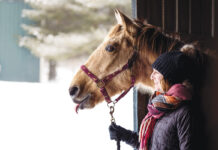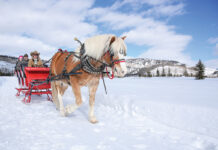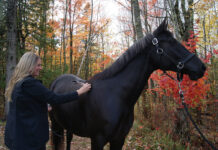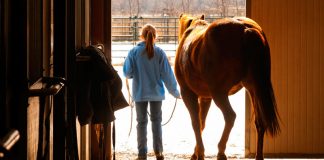Find out what items you need for a comprehensive first aid kit to handle any kind of horse emergency.

My friend is still relatively new to horse ownership, so she wasn’t sure what to do. Being a few hours away, I couldn’t be there to help, but I told her to keep the horse up and walking, and call the veterinarian. Thankfully, her horse came out of it, and they got some pretty funny videos of her after the vet administered some medication that made her woozy. She fell asleep standing up and snored with her tongue hanging out!
That ordeal made me realize that my own horse first aid kit needed to be upgraded. We had some basics, but it wasn’t complete. I started researching the most essential items, but also found some things I would have never thought of that could come in handy during an emergency.
Below, find a list of items to keep in your horse first aid kit, broken down by different needs and circumstances.
Horse First Aid Kit: Emergency & General Care
Horses are hardy animals, but more often than not, they manage to get themselves into some kind of scrape. While many injuries and illnesses can be treated at home, having the right tools on hand is essential. Here’s a list of emergency and general first aid items to keep stocked in both your barn and trailer.
Items Needed:
- Stethoscope: To check heart rate and gut sounds
- Gloves (disposable latex or nitrile): For clean handling of wounds and medications
- Twitch or sedation alternative: If handling an injured horse
- Headlamp or flashlight: For emergencies in low light
- Thermometer: To check temperature
- Syringes: To administer meds
- Needles: For injections
- Electrolyte paste or powder: To help with dehydration recovery
- Activated charcoal or Bio-Sponge: For toxin ingestion concerns
- Notebook or first aid log: To track treatments and vital signs
- Vet & emergency contact list: In case of urgent care needs
Horse First Aid Kit: Pain & Inflammation Management
According to the United States Department of Agriculture (USDA), colic is the most common cause of death in horses that are 1 to 20 years of age and the second most common cause of death for horses older than 20 years of age (USDA APHIS NAHMS 2015). Flunixin meglumine, often known under the name brand name “Banamine,” is a common NSAID used for equine inflammation and pain associated with injuries, but it’s also used to alleviate pain from colic. However, it is highly encouraged to only administer Banamine with a vet’s permission—or, better yet, by the vet themselves.
Phenylbutazone (more commonly known as “bute”) and dimethyl sulfoxide (DMSO) are also common NSAIDs, mainly for joint swelling and injuries, but they’re not great for colic. In fact, if DMSO is administered incorrectly, it can actually cause signs of colic in some horses.
Dormosedan Gel (frequently nicknamed “Dorm gel”) is another good addition. This is an oral sedative for calming a panicked or uncooperative horse in stressful situations.
Be sure to talk with your vet about directions for use and follow all medication guidelines.
Items Needed:
- Bute: Pain relief, anti-inflammatory
- DMSO: Anti-inflammatory
- Dorm gel: Oral sedative
- Topical cooling gel or liniment: For muscle soreness
Horse First Aid Kit: Wound Care & Bandaging
If you are treating a wound, it’s important to inspect the wound for depth and infection. If the wound is too deep, it can lead to an abscess and it will require a call to the vet. Wounds on the eye also warrant an immediate call to the vet.
When cleaning a wound, remove debris and wash with soap and water if possible. Avoid hydrogen peroxide or alcohol on open wounds as they can delay healing. Instead, use wound spray or antibiotic ointment.
Items Needed:
- Non-stick gauze: For wrapping wounds
- Cling gauze: Secures dressings without adhesive
- Gauze pads: Absorbs wound fluids
- Vet wrap: Self-adhesive bandage
- Elastikon: Strong adhesive tape
- Bandage scissors: For careful cutting of bandaging items
- Cast padding: Prevents pressure sores
- Duct tape: Secures hoof wraps
- Absorbine Silver Honey®: Antimicrobial wound care
- Triple antibiotic: Prevents infections
- Wound spray: Disinfects wounds
- Saline solution: Flushes wounds/eyes
- Hydrogen peroxide (3%): For cleaning tools, but not recommended for wounds
- Betadine (povidone-iodine solution or scrub): Antiseptic for cleaning wounds
- Cold packs or instant ice packs: For swelling and injuries
Horse First Aid Kit: Hoof Care
If your horse suddenly starts limping, chances are it’s a hoof abscess. Check for heat, swelling, tenderness, or drainage from the hoof. Treating an abscess often involves soaking the hoof in warm Epsom salt water or applying a poultice to draw out the infection. Wrapping the hoof or using a boot helps keep it clean and protected.
Items Needed:
- Bandaging items: See above
- Duct tape: Secures hoof wraps
- Soaking boot: Easy way to soak a hoof and keep out debris
- Epsom salt: Soaks abscesses and reduces swelling
- Animalintex: Poultice pad for infections
- Green poultice: Cooling clay poultice
- Magic Cushion®: Hoof packing for pain relief
- Hoof pick: To check for lodged objects and clean the hoof
- Diapers or sanitary pads: Great for hoof abscess wraps
- Soft-Ride Boots or hoof boots: If dealing with a hoof injury
Talk With Your Vet
Be sure to talk with your veterinarian about your first aid kit. They can recommend additional items tailored to your horse’s specific needs, explain best practices for administering medications and treating injuries, and may even offer pre-made first aid kits.
Emergencies and injuries are inevitable, but having a well-stocked equine first aid kit can make all the difference. Acting quickly gives your horse the best chance at a full recovery. While some situations will still require a vet, being prepared allows you to stabilize your horse until help arrives. When the unexpected happens, you’ll be glad you took the time to get ready.





